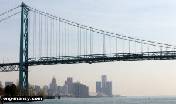Fixing The West Coasts Busiest Bridge 2 From 3

The first task was to install a steel framed trestle platform to give work crews access to the site and eliminate the potential for materials to fall into the San Francisco Bay.
Because the bridge was open to traffic, materials had to be delivered by boat. Once the platform was complete, crews roughened The crossbeam surface and epoxied more than 3,000 drilled dowels into place. The dowels were used to-secure the new concrete and post-tensioning cables to the face of the crossbeam.
Reinforcing steel and post-tensioning cable ducts were then installed by Harris Salinas Rebar, Livermore, Calif. Conco crews followed, placing custom-made post-tensioning trumpet block outs.
The tapered steel wedges were attached to the post-tensioning cables to secure them after tensioning.
The trumpet-shaped wedges prevent the cables from retracting after tensioning.
Crews then set forms for the concrete jacket and placed concrete so that all of the dowels and post-tensioning work is embedded inside the new concrete.
It involved a complex series of steel saddles and post-tensioned jacket walls that would provide the required clamping force to secure the bridge deck framing to the crossbeam, or cap beam.
General contractor American Bridge/ manager.



